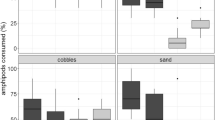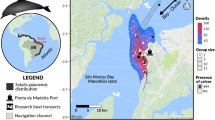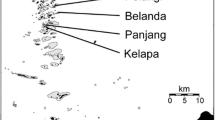Abstract
Japanese dace (Pseudaspius hakonensis) foraging and predator avoidance behaviors were studied in dace schools with and without vicinity predators in Lake Nojiri, Nagano Japan. Dace and invasive smallmouth bass (Micropterus dolomieu), which were the only predator observed, were found interacting in shallow habitat along the shoreline. Dace exhibited remarkably different total foraging, foraging modes, and predator avoidance behavior when smallmouth bass were in vicinity. Total foraging was significantly reduced, foraging mode shifted from predominantly benthic foraging to water column foraging, and dace schooled tighter indicated by a significant decrease in nearest neighbor distance and increase in neighbor alignment. These findings show that in Lake Nojiri, dace recognize smallmouth bass as a predator and utilize predator avoidance behaviors. However, the severely decreased total dace foraging when smallmouth bass are in vicinity indicates that even when direct predation is avoided, the indirect effects of reduced foraging and heightened vigilance likely negatively impact dace growth and survival.

taken from underwater video observations: c Japanese dace schooled and foraging in the water column with two smallmouth bass in vicinity. d Japanese dace feeding benthically with no smallmouth bass in vicinity


Similar content being viewed by others
Data availability
The datasets generated during and/or analyzed during the current study are available in the Knowledge Network for Biocomplexity repository, urn:uuid:462dd074-5cea-4010-a96f-951eed2939f8.
References
Allouche S, Gaudin P (2003) Effects of avian predation threat, water flow and cover on growth and habitat use by chub, Leuciscus cephalus, in an experimental stream. Oikos 94(3):481–492. https://doi.org/10.1034/j.1600-0706.2001.940310.x
Angradi T (2011) Effect of predation risk on foraging behavior of juvenile rainbow trout (Oncorhynchus mykiss). Can J Zool 70(2):355–360. https://doi.org/10.1139/z92-053
Brandl S, Bellwood DR (2015) Coordinated vigilance provides evidence for direct reciprocity in coral reef fishes. Sci Rep 5(1):14556. https://doi.org/10.1038/srep14556
Brown JS, Kotler BP, Bouskila A (2001) Ecology of fear: foraging games between predators and prey with pulsed resources. Ann Zool Fenn 38(1):71–87
Burnham KP, Anderson DR (2002) Model selection and multimodel inference: a practical information-theoretical approach, Wd. Springer-Verlag, New York. https://doi.org/10.1007/b97636
Chilton EW, Muoneke MI (1992) Biology and management of grass carp (Ctenopharyngodon idella, Cyprinidae) for vegetation control: a North American perspective. Rev Fish Biol Fisheries 2:283–320. https://doi.org/10.1007/BF00043520
Creel S, Schuette P, Christianson D (2014) Effects of predation risk on group size, vigilance, and foraging behavior in an African ungulate community. Behav Ecol 25(4):773–784. https://doi.org/10.1093/beheco/aru050
David P, Thebault E, Anneville O, Duyck P-F, Chapuis E, Loeuille N (2017) Impacts of invasive species on food webs: a review of empirical data. Adv Ecol Res 56:1–60. https://doi.org/10.1016/bs.aecr.2016.10.001
Doherty TS, Glen AS, Nimmo DG, Ritchie EG, Dickman CR (2016) Invasive predators and global biodiversity loss. PNAS 113(40):11261–11265. https://doi.org/10.1073/pnas.1602480113
Draulans D (1987) The effect of prey density on foraging and success of adult and first-year grey herons (Ardea cinerea). J Anim Ecol 56(2):479–493. https://doi.org/10.2307/5062
Ecological Society of Japan (2002) Handbook of Alien Species in Japan, Chijinshokan, Tokyo. (in Japanese)
Fausch KD, Nakano S, Kitano S (1997) Experimentally induced foraging mode shift by sympatric charrs in a Japanese mountain stream. Behav Ecol 8(4):414–420
Ferrari MCO, Wisenden BD, Chivers DP (2010) Chemical ecology of predator-prey interactions in aquatic ecosystems: a review and prospectus. Can J Zool 88(7):698–724. https://doi.org/10.1139/Z10-029
Gautrais J, Ginelli F, Fournier R, Blanco S, Soria M, Chate H, Theraulaz G (2012) Deciphering interactions in moving animal groups. PLOS Comput Biol 8(9):e1002678
Hasegawa K, Maekawa K (2008) Potential of habitat complexity for mitigating interference competition between native and non-native salmonid species. Can J Zool 86(5):386–393. https://doi.org/10.1139/Z08-015
Jackson DA (2002) Ecological effects of Micropterus introductions: the dark side of black bass. Am Fish Soc Symp 31:221–232
Katano O, Aonuma Y (2001) Maximum length of Japanese dace Tribolodon hakonensis preyed on by smallmouth bass Micropterus dolomieu. Fish Sci 67(5):866–873. https://doi.org/10.2331/suisan.67.866
Katano O, Aonuma Y (2002) An experimental study of the effects of smallmouth bass on the behavior, growth and survival of prey fish. Fish Sci 68:803–814. https://doi.org/10.1046/j.1444-2906.2002.00496.x
Katano O, Matsuzaki SS (2012) Biodiversity of freshwater fishes in Japan in relation to inland fisheries. The Biodiversity Observation Network in Asia-Pacific Region: Towards Further Development of Monitoring, pp 431–444
Katano O, Aonuma Y, Iguchi K, Yodo T, Matsubara N (2003) Difference in response by two cyprinid species to predatory threat from the nocturnal catfish Silurus asotus. Ichthyol Res 50:349–357. https://doi.org/10.1007/s10228-003-0177-3
Krause J, Godin JG (1996) Influence of prey foraging posture on flight behavior and predation risk: predators take advantage of unwary prey. Behav Ecol 7(3):264–271. https://doi.org/10.1093/beheco/7.3.264
Magnhagen C (1988) Changes in foraging as a response to predation rish in two gobiid fish species, Pomatoschistus minutus and Gobius niger. Mar Ecol Prog Ser 49(1–2):21–26. https://doi.org/10.3354/meps049021
Mark BB, Finn JT, Brooke H (1985) Quantifying stream substrate type for habitat analysis studies. N Am J Fish Manag 5(3B):499–500. https://doi.org/10.1577/1548-8659(1985)5%3c499:QSSFHA%3e2.0.CO;2
Marras S, Domenici P (2013) Schooling fish under attack are not equal: some lead, others follow. PLoS ONE 8(6):e65784. https://doi.org/10.1371/journal.pone.0065784
Matsuzaki SS, Kadoya T (2015) Trends and stability of inland fishery resources in Japanese lakes: introduction of exotic piscivores as a driver. Ecol Appl 25(5):1420–1432. https://doi.org/10.1890/13-2182.1
Nakamura T, Katano O, Yamamoto S (2004) Effects of aquatic plant zones on the reduction of predation pressure on Japanese native fishes by smallmouth bass Micropterus dolomieu. Aquac Sci 52(3):287–291
Peng J, Cao ZD, Fu SJ (2014) Effects of temperature and digestion on the swimming performance of juvenile Chinese bream. Aquat Biol 21(3):183–189. https://doi.org/10.3354/ab00584
Peterson MI, Kitano S (2019) Stream drift feeding and microhabitat competition of invasive smallmouth bass Micropterus dolomieu, native Japanese dace Tribolodon hakonensis and pale chub Opsariichthys platypus in the Nogu River, Japan. Environ Biol Fish 102:69–79. https://doi.org/10.1007/s10641-019-0844-5
Peterson MI, Kitano S (2021) Habitat dependent predation-competition interaction shifts of invasive smallmouth bass (Micropterus dolomieu) and resident cyprinids in the Chikuma River, Nagano Japan. Environ Biol Fish 104:155–169. https://doi.org/10.1007/s10641-021-01067-x
Peterson MI, Kitano S, Ida H (2020) Spawning season and nesting habitat of invasive smallmouth bass Micropterus dolomieu in the Chikuma River, Japan. Ichthyol Res 67:1–6. https://doi.org/10.1007/s10228-019-00694-w
Peterson MI, Kitano S, Ida H (2021) Resident spawning of Japanese smelt, Hypomesus nipponensis, along gravel shorelines in Lake Nojiri, Central Japan. Landscape Ecol Eng. https://doi.org/10.1007/s11355-021-00462-x
R Core Team (2021) R: a language and environment for statistical computing. R Foundation for Statistical Computing, Vienna. https://www.R-project.org/
Rahel FJ, Taniguchi Y (2019) A comparison of freshwater fisheries management in the USA and Japan. Fish Sci 85:271–283. https://doi.org/10.1007/s12562-019-01291-6
Reinhardt UG, Healey M (1997) Size-dependent foraging behavior and use of cover in juvenile coho salmon under predation risk. Can J Zool 75(10):1642–1651. https://doi.org/10.1139/z97-791
Strauss S, Lau J, Carroll SP (2006) Evolutionary responses of natives to introduced species: what do introductions tell us about natural communities? Ecol Lett 9(3):357–374. https://doi.org/10.1111/j.1461-0248.2005.00874.x
Tang ZH, Huang Q, Wu H, Kuang L, Fu SJ (2017) The behavior response of prey fish to predators: the role of predator size. PeerJ 5:e3222. https://doi.org/10.7717/peerj.3222
Tran TNQ, Jackson MC, Sheath D, Verreycken H, Britton JR (2015) Patterns of trophic niche divergence between invasive and native fishes in wild communities are predictable from mesocosm studies. J Anim Ecol 84:1071–1080. https://doi.org/10.1111/1365-2656.12360
Tugend KI, Allen MS, Webb M (2002) Use of artificial habitat structures in US lakes and reservoirs: a survey from the southern division AFS reservoir committee. Fisheries 27(5):22–27. https://doi.org/10.1577/1548-8446(2002)027%3c0022:UOAHSI%3e2.0.CO;2
Turney S, Godin JG (2014) To forage or hide? Threat-sensitive foraging behavior in wild, non-reproductive passerine birds. Current Zoology 60(6):719–728. https://doi.org/10.1093/czoolo/60.6.719
Wakiya R, Mochioka N (2021) Contrasting diets of the Japanese eel, Anguilla japonica, in the upper and lower areas of Tsuchikawa-gawa River, Kagoshima, Japan. Ichthyol Res 68:145–151. https://doi.org/10.1007/s10228-020-00755-5
Yodo T, Iguchi K (2003) Feeding habits of introduced smallmouth bass in lakes Aoki and Nojiri, Japan. Jpn J Ichthyol 50(1):47–53. https://doi.org/10.11369/jji1950.50.47 (In Japanese)
Yodo T, Iguchi K (2004) Feeding habits of the alien species, smallmouth bass in the Nogu River, Central Japan. Aquac Sci 52(4):395–400. https://doi.org/10.11233/aquaculturesci1953.52.395 (In Japanese)
Acknowledgements
We thank the Nojiriko Fisherman’s Cooperative Association for their agreement to allow observation and underwater video recording of fish species in Lake Nojiri as well as providing helpful background information. We also thank Mamoru Matsuki (Issa Restaurant) for providing valuable background information and the Nojiri Lake Association for granting access to their docks and swimming area. We thank author MIP’s advisor, Prof. Hideyuki Ida (Shinshu University), for his assistance in data analysis and manuscript editing. Author MIP is a Research Fellow of Japan Society for the Promotion of Science.
Author information
Authors and Affiliations
Corresponding author
Ethics declarations
Ethics approval
All experiments comply with the current laws of Japan, and permission for the study was granted by the Nojiriko Fisherman’s Cooperative Association.
Conflict of interest
The authors declare no competing interests.
Additional information
Publisher's note
Springer Nature remains neutral with regard to jurisdictional claims in published maps and institutional affiliations.
Rights and permissions
About this article
Cite this article
Peterson, M.I., Kitano, S. Changes in foraging and predator avoidance behavior of Japanese dace (Pseudaspius hakonensis) to predation risk by invasive smallmouth bass (Micropterus dolomieu) in a Japanese lake. Environ Biol Fish 104, 1381–1389 (2021). https://doi.org/10.1007/s10641-021-01166-9
Received:
Accepted:
Published:
Issue Date:
DOI: https://doi.org/10.1007/s10641-021-01166-9




